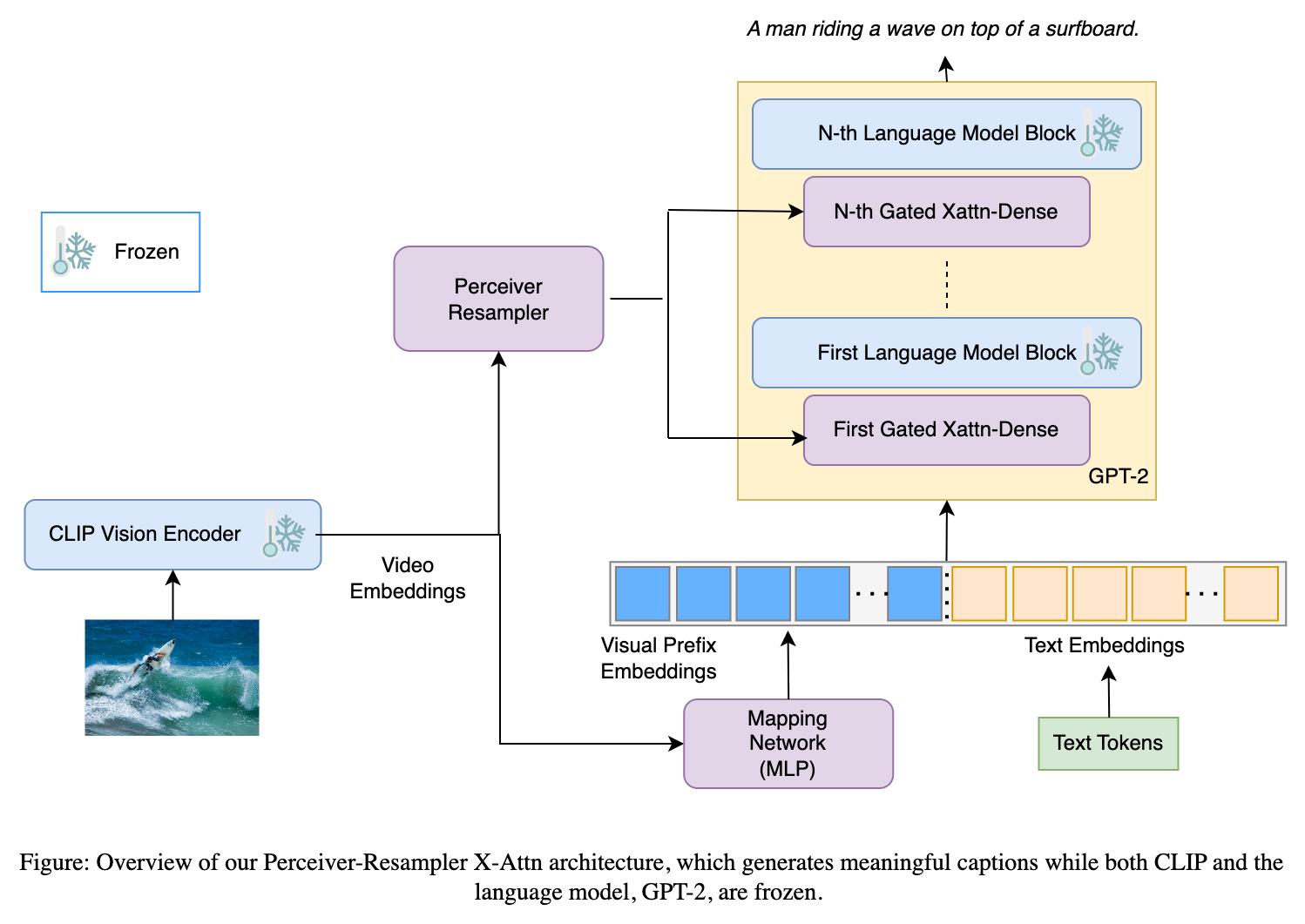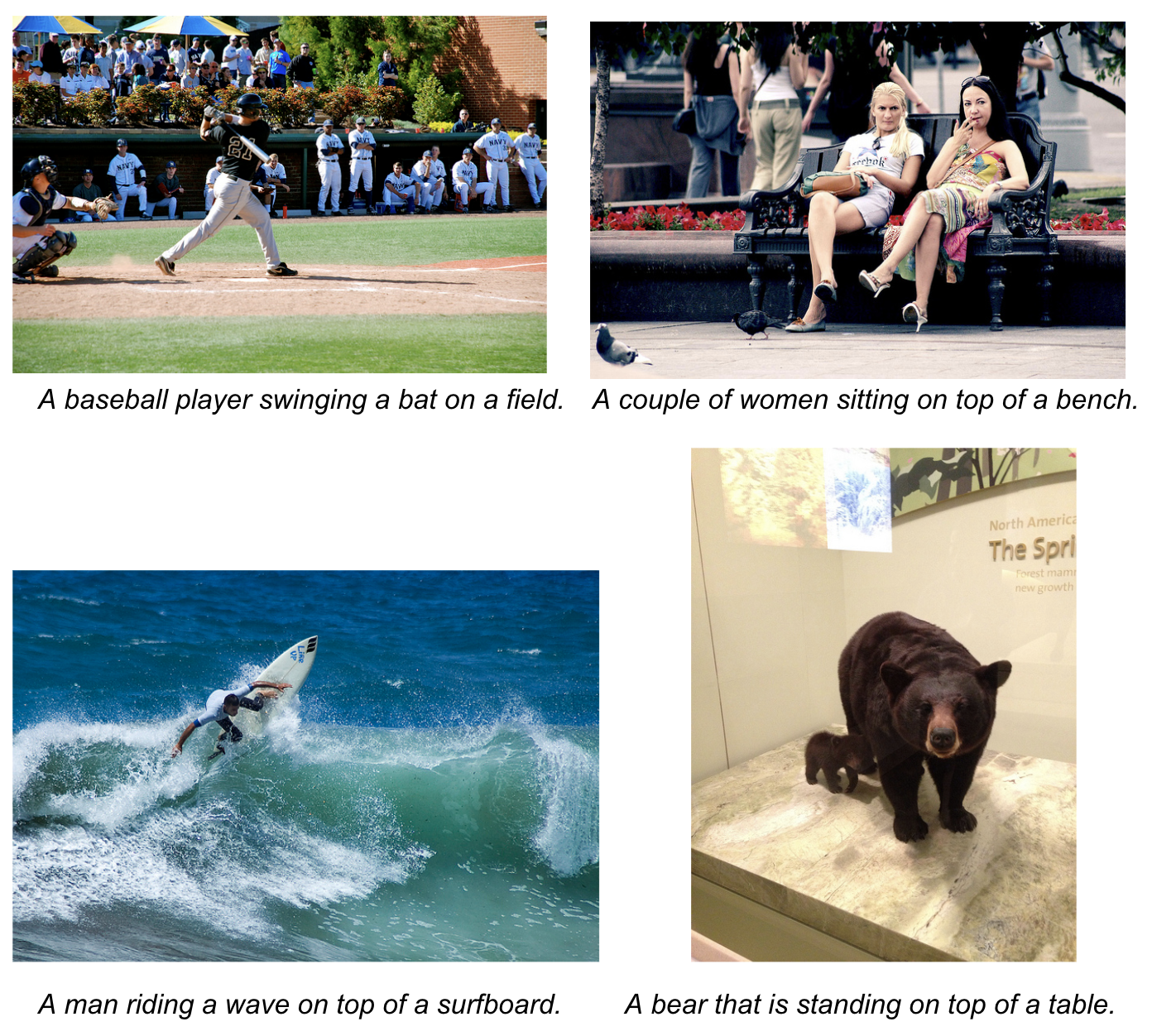In this project, we demonstrate the ability to describe images in natural languages by employing the few-shot cross-domain applicability of the large vision and language models such as CLIP and GPT2 respectively. Specifically, we show that using a pre-trained image encoder along with a text generator can work right out-of-the-box for image caption generation tasks provided we are able to devise an effective way to tune the image encoder outputs to conform to the text generator weights. We approach this problem by introducting a perceiver-resampler network with gated cross attention layers and a mapping network between the frozen encoder and the frozen generator.
We provide more details on the model architecture as well as how to setup and run the project in the sections below.
Install all the project dependencies with
$ pip install -r requirements.txt
Our model architecture consists of three parts: a pre-trained image encoder, a pre-trained text generator and a bridge to connect the encoder with the generator. For the image encoder, we use a pre-trained ViT-based CLIP vision model and for the text generator, we use a pre-trained GPT2. The bridge consists of two sub-parts: a perceiver resampler network with gated cross-attention to provide additional visual context to the GPT2 layers and a mapper network to tune the CLIP outputs to conform to the weights of GPT2.
For more in-depth details of the architecture like the structure of the perceiver-resampler network, the gated cross-attention layers, the mapper network and how to feed the image embeddings to these structures, please checkout the README in the model/ directory.
The model with the perceiver-resampler network and the MLP mapper network enabled, achieves a BLEU4 score of 31.21 on the COCO validation set. All the results shown below are for the models trained with the default set of hyperparameters present in config.yaml with the exception of enable_resampler_xattn=False for the Mapping Network row and enable_mapper=False for the Perceiver-Resampler row.
The Mapping Network + Perceiver Resampler model generates high quality descriptions of images in natural language. Some generated samples are shown below.
The training scripts and the model architecture can support can image-to-text and video-to-text tasks right out of the box. What needs to be changed is the dataset class in dataset.py to support your own dataset. However, the current codebase offers the code to create data loaders only for the MSCOCO and the MLSLT (Multiligual Sign-Language Translation) dataset.
For instructions on how to download and setup the dataset, check the README in the data/ directory.
For training a model with the hyperparamters present in config.yaml, run
$ python run.py \
--config-path=<Directory containing the config file> \
--config-name=config.yaml \
name=<name of the experiment> \
mode=train \
dataset.train_ds.visual_dir=<Directory containing the videos or images for train set> \
dataset.train_ds.json_path=<Path to the json file with the transcripts for train set> \
dataset.validation_ds.visual_dir=<Directory containing the videos or images for validation set> \
dataset.validation_ds.json_path=<Path to the json file with the transcripts for validation set> \
trainer.exp_dir=<Directory to save the checkpoints and logs>
After training, you can use the command below to evaluate your models.
Don't feel like training a model yet? No worries, you can download a checkpoint that we trained using the default configuration present in config.yaml from here.
To evaluate on the test set, run
HYDRA_FULL_ERROR=1 python run.py \
--config-path=<Directory containing the config file> \
--config-name=config.yaml \
name=<name of the experiment> \
mode=test \
pretrained_name=<path to the checkpoint> \
dataset.test_ds.visual_dir=<Directory containing the videos or images for test set> \
dataset.test_ds.json_path=<Path to the json file with the transcripts for test set> \
trainer.exp_dir=<Directory to save the logs>
NOTE: The commands given above train or evaluate the model based on the default set of hyperparameters given in config.yaml. To tweak those values, please specify them explicitly via the command line.
If you need any help or want to report a bug, feel free to raise an issue in the repo.


